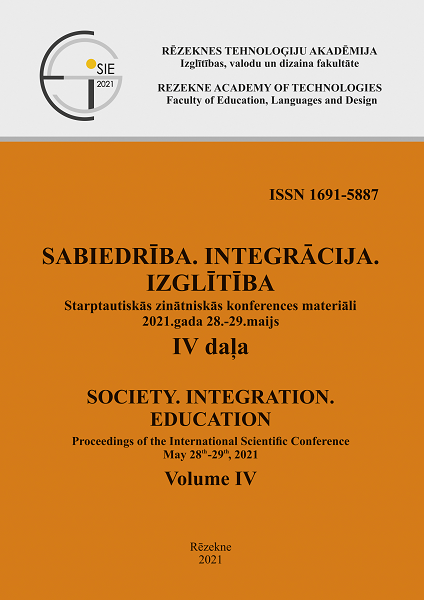RESEARCH ACTIVITY OF STUDENTS IN THE APPLICATION OF LASER PROCESSING AND 3D PRINTING TECHNOLOGIES IN TEXTILE FABRICS
DOI:
https://doi.org/10.17770/sie2021vol4.6408Keywords:
3D printing, laser technologies, projects, independent research activities, textilesAbstract
Nowadays education and research promote interdisciplinary cooperation and development. An interdisciplinary approach creates change and new opportunities for design education in general, while innovation, the use of advanced materials and technologies transforms design technology studies. These changes affect the development of design technology as an integrated interdisciplinary direction, the creation of innovative solutions, products and services in research design activities. This process is facilitated by research grant projects involving students and researchers. The performed experimental research in Rezekne Academy of Technologies (RTA) engineering research centres shows the possibilities of laser processing and 3D printing in textile fabrics design, promotes innovative technological solutions in product design and ensures the development of scientifically based results. The aim of the research is to improve students' independent research activities in purposeful project activities by interacting with various engineering research centers. Research methods used: theoretical - literature and Internet resource research and analysis, empirical - action (case study) research. Eight students of engineering/design study programs and four lecturers – researchers - participants of grant projects - participate in the research. Research period 2017–2020. The research has a practical significance, because it substantiates the interdisciplinary experimental research activity process and results, determining of students' independent research activity improvement direction, promotes the transfer of research results into practice.
Downloads
References
Abel, C.F. (2002). Academic Success and the International Student: Research and Recommendations. New Directions for Higher Education, 117, 13-20. 8.p DOI: https://doi.org/10.1002/he.42
Angelova, Y., Lazov, L., Mežinska, S. (2017). Innovative Laser Technology In Textile Industry: Marking and Engraving. Internacional Scientific and Practical Conference Environment. Technology. Resources, 3, 15-22. http://dx.doi.org/10.17770/etr2017vol3.2610
Behroodi, E., Latifi, H., Bagheri, Z., Ermis, E., Roshani, S., Salehi M. M. (2020). A combined 3D printing/CNC micro‑milling method to fabricate a large‑scale microfluidic device with the small size 3D architectures: an application for tumor spheroid production. Scientific Reports, 10(1), 1-14. DOI: 10.1038/s41598-020-79015-5
Belavy, D. L., Owen, P. J., Livingston, P. M. (2020). Do successful PhD outcomes reflect the research environment rather than academic ability? PLoS ONE, 15(8), 1-14. DOI: https://doi.org/10.1371/journal.pone.0236327
Breen, R., Lindsay, R. (1999). Academic Research and Student Motivation. Studies in Higher Education, 24(1), 75. 19p. https://doi.org/10.1080/03075079912331380158
Burke, S., Sinclair, R. (2015). Computer-Aided Design (CAD) and Computer-Aided Manufacturing (CAM) of Apparel and other Textile Products. Textiles and Fashion. Materials, Design and Technology, 1671-1703. DOI: 10.1016/B978-1-84569-931-4.00027-1
Kan, C. W. (2014). CO₂ laser treatment as a clean process for treating denim fabric. Journal of Cleaner Production, 66, 624-631. Database: ScienceDirect.
Lipskaya, L. A. (2006). Philosophical-anthropological foundations of modern education. Pedagogy, 2, 23 -28.
Lu, S., Mok, P. Y., Jin, X (2017). A new design concept: 3D to 2D textile pattern design for garments. Computer-Aided Design, 89, 35–49. DOI: https://doi.org/10.1016/j.cad.2017.03.002 Database: ScienceDirect
Mahrle, A., Beyer, E. (2009). Theoretical aspects of fibre laser cutting. Journal of Physics D:Applied Physics, 42(17), 175507. Database: GoogleScholar.
Mežinska, S., Kangro, I., Zaicevs, E., Salmane, G. (2020). The effect of 3d printing on a textile fabric. Proceedings of the Internacional Conference Society, Integration. Education, 5, 729.-739. DOI: https://doi.org/10.17770/sie2020vol5.5012
Mizell, H. (2010). Why Professional Development Matters. Oxford: Learning Forward. Retrieved from https://learningforward.org/wp-content/uploads/2017/08/professional-development-matters.pdf
Mizuno, D. (2014). Open design and digital fabrication in fashion. In A. Gwilt (Edit.), Fashion design for living (pp. 114-130). London: Routledge. DOI: https://doi.org/10.4324/9781315770758 Database: Taylor&Francis eBooks.
Narica, P., Pacejs, A., Laizāne, R., Mežinska, S. ( 2019). Analysis of Laser Processing of Artificial Leather. Internacional Scientific and Practical Conference Environment. Technology. Resources, Vol. 3, 177-183. DOI: https://doi.org/10.17770/etr2019vol3.4040
Nayak, R., Padhye, R. (2016). The use of laser in garment manufacturing: an overview. Fashion and Textiles, 3(5). Retrieved from: https://link.springer.com/article/10.1186/s40691-016-0057-x
Noorani, R. (2017). 3D printing. Technology. Applications and Selection. eBook. Pub. Location Boca Raton CRS Press. DOI https://doi.org/10.1201/9781315155494
Ondogan, Z., Pamuk, O., Ondogan, E. N., & Ozguney, A. (2005). Improving the appearance of all textile products from clothing to home textile using laser technology. Optics & Laser Technology, 37(8), 631–637. Database: Academic Search Complete (EBSCOhost)
Ramiscat, N. G. (2016). You Can 3D Print Your Dress and Wear It Too: A Seminal Look at the Possible Legal Issues of 3D Printing in the Philippine Fashion Industry. Atene Law Journal, 60(4), 1045-1071.
Scaturro, S. (2008). Eco-tech Fashion: Rationalizing Technology in Sustainable Fashion. Fashion Theory: The Journal of Dress, Body & Culture, 12(4), 469-488. DOI: https://doi.org/10.2752/175174108X346940
Shah, J., Snider, B., Clarke, T., Kozutsky, S., Lacki, M., Hosseini, A. (2019). Large-scale 3D printers for additive manufacturing: design considerations and challenges. International Journal of Advanced Manufacturing Technology, 104(9-12), 3679-3693.
Unrau, Y.A., Beck, A. R. (2004). Increasing Research Self-Efficiency Among Students in Professional Academic Programs. Innovative Higher Education, 28(3), 187-204. Retrieved from http://www.springerlink.com
Vanderploeg, A., Lee, S., Mamp, M. (2017). The application of 3D printing technology in the fashion industry. International Journal of Fashion Design, Technology & Education, 10(2), 170-179. DOI: https://doi.org/10.1080/17543266.2016.1223355
Wahl, L. (2019). Introducing fashion students to direct 3D printing on fabric. Techniques: Connecting Education & Careers. 94(4), 34-39.
Žogla, I., Ļubkina, V. (2020). Doktoranta pētniecības kompetence. Izglītības reforma: izglītības satura pētījumi un ieviešanas problēmas, 1, 42-56.


